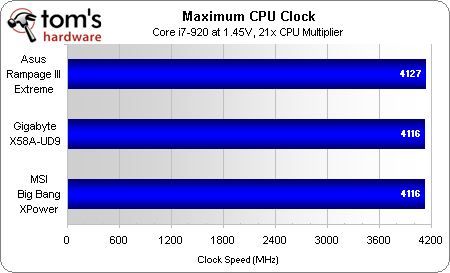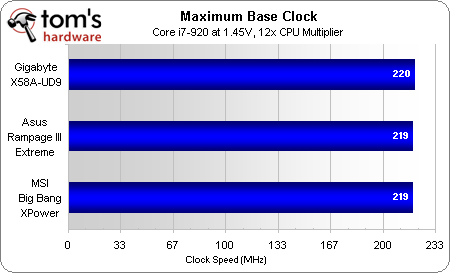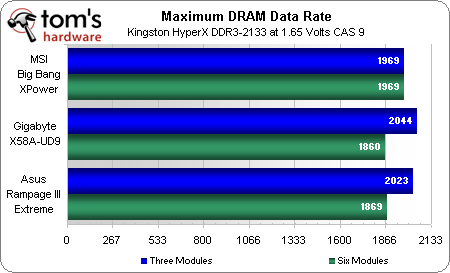X58 To The Max: Three New Flagship LGA 1366 Motherboards
Supporting Intel’s highest-performance processors with twice the bandwidth of its mainstream counterpart, the X58 chipset proves the staying power of good ideas. We take a closer look at what makes the latest generation of premium motherboards special.
Overclocking
All three boards in today’s competition offer voltage levels in excess of what most users actually need, but competitors who use liquid nitrogen cooling will be happy to see these ultra-high limits.
| BIOS Frequency and Voltage settings (for overclocking) | |||
|---|---|---|---|
| Row 0 - Cell 0 | Asus Rampage III Extreme | Gigabyte X58A-UD9 | MSI Big Bang XPower |
| CPU Base Clock | 100-500 MHz (1 MHz) | 100-600 MHz (1MHz) | 100-600 MHz (1 MHz) |
| CPU Multiplier | Yes | Yes | Yes |
| DRAM Data Rates | BCLK x6-x18 (x2) | BCLK x6-x18 (x2) | BCLK x6-x16 (x2) |
| PCIe Clock | 100-200 MHz (1 MHz) | 90-150 MHz (1 MHz) | 100-190 MHz (1 MHz) |
| CPU Vcore | 0.85-2.30 V (6.25 mV) | 0.50-1.90 V (6.25 mV) | 0.90-2.30 V (6.25 mV) |
| Uncore Voltage | 1.20-2.50 (6.25 mV) | 1.075-2.015 V (20 mV) | 1.20-1.83 V (6.25 mV) |
| IOH Voltage | 1.11-2.20 V (13.25 mV) | 1.00-2.00V (20 mV) | 0.80-1.70 V (10 mV) |
| ICH Voltage | 1.11-2.00 V (13.25 mV) | 0.92-2.38 V (20 mV) | 1.10-2.00 V (10 mV) |
| DRAM Voltage | 1.21-2.50 V (13.25 mV) | 1.30-2.60 V (20 mV) | 1.20-2.50 V (1 mV) |
| CAS Latency | 3-11 Cycles | 5-15 Cycles | 4-15 Cycles |
| tRCD | 3-15 Cycles | 1-15 Cycles | 3-15 Cycles |
| tRP | 3-15 Cycles | 1-15 Cycles | 3-15 Cycles |
| tRAS | 3-31 Cycles | 1-31 Cycles | 9-31 Cycles |
Our air-cooled configuration and first-generation Core i7 processor limit us to a far more practical 1.45 V, a configuration we’ve maintained through several product generations to make comparisons of overclocking capabilities possible between articles.
This is the closest we’ve seen any three boards come to overclocking parity, indicating the true limit of our CPU at our chosen voltage. The actual difference is less than the 21 MHz we’d get from increasing the base clock by 1 MHz, so all three boards are tied within the “margin of error” for each board’s clock generator.
Base-clock capability is also essentially tied for all three boards, with Gigabyte’s 220 MHz setting coming in at an actual 219.8 MHz.
Memory is where things get a little trickier. MSI appears to lead in the average of three- and six-module speeds, but it’s hard to know exactly where it would have ended up had its 7x memory multiplier actually worked. That’s right, MSI’s memory overclock started at the DDR3-1600 setting rather than the DDR3-1866 setting used by its competitors, requiring a higher base clock to reach its memory overclocking limit.
Get Tom's Hardware's best news and in-depth reviews, straight to your inbox.
Current page: Overclocking
Prev Page Benchmark Results: Synthetic Next Page Power, Heat, And Efficiency-
one-shot No EVGA SR-2? :(Reply
Ok, Hold on. Three Flagship LGA 1366 Boards and no overclocked power consumption results? These boards are obviously made for overclocking and those results would be very interesting to see. -
Lmeow Reply9498281 said:No EVGA SR-2? :(
The EVGA Classified SR-2 is based on the Intel 5520 chipset and uses Xeons, so it's not an X58 board technically speaking which is why it doesn't qualify. ;)
If I could spend that much on a motherboard I'd have chosen the Rampage III Extreme, not only does it have good features it also has the best colour scheme. ^^
Does anyone know why I try to submit a comment it doesn't show up, and I have to use the forums instead to post a comment instead? -
sudeshc I am totally impressed by ASUS they always come up with best solution in every category, but the price is a killer for me :(Reply
-
rottingsheep IMO, the only interesting part about motherboard reviews is the overclocking and power consumption portion.Reply -
avatar_raq Nice article..I have only catch: Of all the mobos tested, Quad SLI is not possible on the ASUS R3E, courtesy of nVIDIA's driversReply
http://www.guru3d.com/news/quad-sli-on-asus-rampage-iii-extreme-is-not-possible/ -
dragonfang18 Whats the point when Intel will come out with new processors with different sockets next year?Reply -
Crashman avatar_raqNice article..I have only catch: Of all the mobos tested, Quad SLI is not possible on the ASUS R3E, courtesy of nVIDIA's drivershttp://www.guru3d.com/news/quad-sl -possible/Awesome, thanks. Manufacturers don't actually discuss this stuff.Reply
dragonfang18Whats the point when Intel will come out with new processors with different sockets next year?That's what people like you were saying months before LGA 1156 was released. We see which direction that went. -
dragonfang18 ReplyThat's what people like you were saying months before LGA 1156 was released. We see which direction that went.
Yeah... they are changing 1366 to some socket R... Well... At least I can look forward to these motherboards going down in price by next year when they go to Socket R's for performance than 1366's. I guess ill be happy with 1366's. Hopefully they go down by at least $100.



